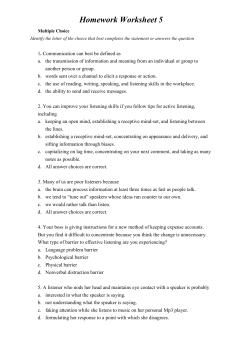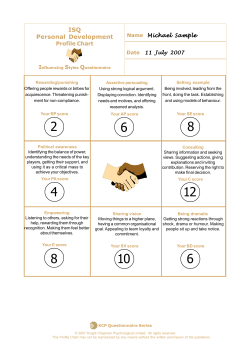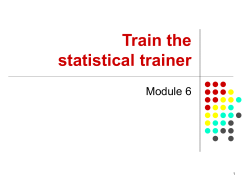
Communicating in the Digital Age Chapter Fourteen McGraw-Hill/Irwin
Communicating in the Digital Age Chapter Fourteen McGraw-Hill/Irwin © 2013 The McGraw-Hill Companies, Inc. All rights reserved. Copyright © 2013 by The McGraw-Hill Companies, Inc. All rights reserved. Learning Objectives LO.1 Explain the perceptual process model of communication, and describe the barriers to effective communication. LO.2 Specify two major impacts of social media that are changing the general communication landscape. LO.3 Contrast the communication styles of assertiveness, aggressiveness, and nonassertiveness. LO.4 Discuss the primary sources of nonverbal communication. LO.5 Review the five dominant listening styles and 10 keys to effective listening. 14-2 Learning Objectives (cont.) LO.6 Describe how linguistic styles vary for women and men and what can be done to improve everyone’s communication effectiveness. LO.7 Discuss the formal and informal communication channels. LO.8 Explain the contingency approach to media selection. LO.9 Describe the Internet generation, and discuss the pros and cons of teleworking. LO.10 Specify practical tips for more effective e-mail and cell phone etiquette, and discuss policies for using social media Web sites in the workplace. 14-3 Basic Dimensions of the Communication Process Communication the exchange of information between a sender and receiver and the inference (perception) of meaning between the individuals involved 14-4 Communication Process in Action 14-5 A Perceptual Model of Communication Sender person wanting to communicate information-the message Receiver person, group, or organization for whom the message is intended Encoding translates thoughts into code or language that can be understood by others 14-6 Question? Alexa is informing her subordinates that the expense reimbursement policy for travel has been significantly modified. Alexa would be considered which of these? A.Decoder B.Medium C.Sender D.Noise 14-7 A Perceptual Model of Communication Selecting a Medium depends on the nature of the message, its intended purpose, the audience, proximity to the audience, time constraints, and personal skills and preferences. 14-8 A Perceptual Model of Communication Decoding occurs when receivers receive a message process of interpreting and making sense of a message Feedback the sender gets a reaction from the receiver 14-9 A Perceptual Model of Communication Noise anything that interferes with the transmission and understanding of a message 14-10 Potential Breakdowns in the Communication Process Itself 14-11 Barriers to Effective Communication 1. Personal barriers any individual attribute that hinders communication 2. Physical barriers 3. Semantic barriers 14-12 Personal Barriers 1. Variable skills in communicating effectively 2. Variations in how information is processed and interpreted 3. Variations in interpersonal trust 4. Stereotypes and prejudices 5. Big egos 14-13 Personal Barriers (cont.) 6. Poor listening skills 7. Natural tendency to evaluate other’s messages 8. Inability to listen with understanding 9. Nonverbal communication 14-14 Physical Barriers Time zone differences Telephone-line static Distance from others Crashed computers Office design 14-15 Question? Laura works at an office with low-walled cubicles. There is often a lot of background noise and Laura has trouble hearing clients on the phone. This is an example of a ________ barrier. A.Process B.Physical C.Personal D.Semantic 14-16 Barriers to Effective Communication Semantics study of words Semantic barriers problems with language in communication fueled by the growing trend to outsource customer service operations to foreign countries like India 14-17 Barriers to Effective Communication Jargon represents language or terminology that is specific to a particular profession, group, or company 14-18 Interpersonal Communication Communication competence the ability to communicate effectively in specific situations 14-19 Question? Sunil has an expressive and self-enhancing communication style, which is based on the notion that it is not right or good to violate our own or others' basic human rights. Sunil can be described as having which of these styles? A.Aggressive B.Nonassertive C.Nonverbal D.Assertive 14-20 Communication Styles 14-21 Tips for Saying No Don’t feel like you have to provide a yes or no answer on the spot. Be honest, and start your response with the word no. Use nonverbal assertive behaviors to reinforce your words. Use verbal assertive behaviors. 14-22 Nonverbal Communication Nonverbal Communication any message, sent or received independent of the written or spoken word includes such factors as use of time and space, distance between persons when conversing, use of color, dress, walking behavior, standing, positioning, seating arrangement, office locations and furnishings. 14-23 Sources of Nonverbal Communication Body movement and gestures Touch Facial expressions Eye contact 14-24 Question? Travis was in a meeting with his supervisor regarding sales analysis. Travis had his arms folded and legs crossed. Travis's nonverbal behavior communicated which of these? A.Semantics B.Defensiveness C.Aggressiveness D.Immediacy 14-25 Active Listening Listening Process of actively decoding and interpreting verbal messages. requires cognitive attention and information processing 14-26 Listening Styles Appreciative listens for pleasure, entertainment, or inspiration Empathetic interprets messages by focusing on emotions and body language 14-27 Question? Dr. Philip interprets messages by focusing on emotions and body language. His listening style can be described as __________. A.Appreciative B.Empathetic C.Discerning D.Evaluative 14-28 Listening Styles Comprehensive organizes specific thoughts and actions and integrates this information by focusing on relationships among ideas 14-29 Listening Styles Discerning attempt to understand the main message and determine important points Evaluative listen analytically and continually formulate arguments and challenges to what is being said 14-30 The Keys to Effective Listening 14-31 Communication Differences between Women and Men 14-32 Formal Communication Channels Upward communication involves communicating with someone at a higher organizational level Downward communication occurs when someone at a higher level in the organization conveys information or a message downward to one or more others. 14-33 Formal Communication Channels Horizontal communication flows among coworkers and between different work units, and its main purpose is coordination External communication two-way flow of information between employees and a variety of stakeholders outside the organization 14-34 Informal Communication Channels Informal communication channels Do not follow the chain of command or organizational structure. Grapevine Unofficial communication system of the informal organization. 14-35 Informal Communication Channels Liaison individuals Those who consistently pass along grapevine information to others. Organizational moles Those who use the grapevine to enhance their power and status. 14-36 Media Richness Media richness involves the capacity of a given communication medium to convey information and promote understanding based on feedback, channel, type of communication, and language source 14-37 A Contingency Model for Selecting Communication Media 14-38 Protecting against Security and Privacy Breaches on the Internet 14-39 Video: A Week Without Technology: Could You Do It? What business processes are affected by the presence or lack of technology? Is it possible for a company to be competitive today without technology? How is the perceptual model of communication different when technology is used than if it were not? Which types of communication barriers might be different? How are the non-verbal aspects of communication affected by technology? How would you do in Dennis’s situation - could you have lasted the full week? 14-40
© Copyright 2025


















